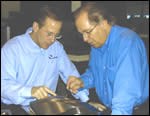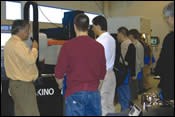Learn to Compete with Negative-Shape Machining
Moldmakers can reduce costs and increase throughput with a high-technology approach.
Share
The steady pressure to cut costs for those in the tool and die and moldmaking industries is well-recognized, even though many are not sure how to accomplish this any more than they already have. Offshore competition, customer and supplier pricing, quality and “art to part” pressures, higher insurance and labor costs, all have taken their toll on shop business owners who couldn’t adapt. Many have closed their doors over the past decade.
How can a high-technology approach in the moldmaking shop meet these demands by reducing costs and increasing throughput? The answer lies in having the latest global precision tooling equipment and processes in place with the ability to consistently machine perfect parts, one after the other, on the first pass. This does not mean merely purchasing a floor full of advanced equipment, turning it on and using it just like your old tools.
To achieve measurable results, shop owners will have to understand that the entire production system must operate flawlessly: it will demand the right part design and build, the right CAD/CAM software, the right tool, the right holder, in addition to a staff of expert, qualified machinists and operators.
Counting Quality
Leading Japanese automakers like Toyota demand “zero tuning” in molds and dies delivered by their suppliers—an insistence on uniformity and consistency in the finished parts. At this moment, however, American automakers are not yet realizing the full benefit from the available advanced technology as are the Japanese.
With too many shops, the emphasis seems to be simply on reducing tooling costs, leadtimes, product pricing and delivery. The quality inherent in getting the part cut right the first time does not weigh as heavily as these other factors, primarily because the American manufacturers are still not as demanding as the Japanese.
When the mold tool is put on the press for the first time, Toyota, for example, will not accept repeated trials and reworked tools. Instead of the traditional method of conducting T1, T2 and T3 tryouts, Toyota engineers want only T1.
Investing in Technology
The performance standards for the industry are thus being set by companies that have invested in advanced technology and are now also profiting from it. Companies that adhere to the old ways of doing things, sooner or later, will wither on the vine.
For example, by routinely machining one side of the mold to zero, leaving no extra stock, and the other side to -0.0008 inch, labor and handwork costs normally involved in tweaking or reworking oversize cores and cavities can be eliminated. And by eliminating time wasted with additional prove-out trials, shorter leadtimes result, along with happy customers.
The initial investment in state-of-the-art machine tool products and software to achieve this precision is considerable, averaging between $200,000 to $400,000. It requires CAM-generated toolpaths in micron resolution matched with a machine capable of one million pulses per revolution. Three- to five-axis milling machines must possess exceptionally high volumetric accuracy, and with high-speed spindles (20,000-30,000 rpm) that exhibit high stiffness, low vibration and outstanding cooling characteristics. Of these parameters, volumetric accuracy is critically important, because it assures that the mold part will not have to be bench-worked by hand for a perfect fit and function.
Transitioning to a Systems Approach
The transition to this technology by the typical mold shop will not be quick or easy. There would be two weeks of training for operators and managers, to teach them how to set up, calibrate and operate the new equipment to its maximum potential. After this break-in period and over the following six months to a year, the company would rapidly expand its knowledge base, efficiency and application capabilities.
Benefits
The benefits are hard to ignore, especially when you consider the alternatives. The automation inherent in this systems approach will lead toward unattended machining, allowing you to extend your hours of operation, while your core staff can handle other responsibilities. The speed of production from your current methods will increase from one-half to 10 times greater.
Thus the advanced tools themselves become value-added assets to the shop. They add reliability, dependability and ultimately predictability to the process. The traditional method varies with the unpredictable performance of the machine tools, and accounts for time wasted in re-working and added costs.
Other gains include extended tool life, reduced carbide costs, reduced hand labor costs in reworking projects and the ability to increase sales opportunities to match the greatly increased throughput of your production process.
Steps
To realize these benefits, a strict set of procedures must be adhered to as follows:
- CAM programs must be calibrated to very tight tolerances of the machine tools that operate with million pulse encoders.
- Toolholders must be balanced for ultra high-speed rpms.
- Shrink-fit collars have to be within one- or two-tenths inches.
- Automatic tool length measurement (ATLM), real-time lasers have to check and maintain spindle growth and vibration to within two microns.
- The cutter head radius must maintain its designated tolerance within two to three microns.
Taking Advantage
Today’s focus on process represents a paradigm shift from the traditional process is not product mindset. Process tools, techniques and experience bring standardization into a facility and permit the sharing of knowledge and best practices across the entire shop. Sharing and standardization lead to self-examination and finally, to continuous improvements of the process itself. This represents a movement toward the unattended machining and predictability that eliminate unnecessary operations, benefiting the business overall.
Some U.S. companies have already begun the journey to being able to cut zero-negative stock, although they only represent about 1 to 2 percent of mold shops. By not using high-accuracy cutters and other equipment, moldmakers are not taking advantage of the capabilities that they could be. To use a football analogy, they would rather settle for field goals instead of going for touchdowns.
Part of the reason for this is that U.S. manufacturers—specifically the automakers—are not yet demanding the quality from their suppliers required to produce a perfect tool in the first shot; rather, they spend time on tryouts to get it right. At some point in the future, however, these businesses are going to lose out to those companies that are always making touchdowns.
Related Content
The In's and Out's of Ballbar Calibration
This machine tool diagnostic device allows the detection of errors noticeable only while machine tools are in motion.
Read MoreLeading Mold Manufacturers Share Best Practices for Improving Efficiency
Precise Tooling Solutions, X-Cell Tool and Mold, M&M Tool and Mold, Ameritech Die & Mold, and Cavalier Tool & Manufacturing, sit down for a fast-paced Q&A focused on strategies for improving efficiencies across their operations.
Read MoreHow to Manage Wall Thickness Changes in Your Mold Design
To ensure even filling and cooling, consider wall section transitions, corners and fillets, ribs and bosses, lip and rim designs and CAE flow simulation software.
Read MoreMold Innovations Power Unique Auto Lighting Elements on Hummer EVs
Diamond machining, electroforming of micro-optical inserts and modified latch-lock system help injection molds produce unique forward lighting elements.
Read MoreRead Next
Operations Reassessment Yields Customer Diversification, Increased Competitiveness and Improved Capabilities
The recession came early to Michigan shops serving the automotive industry. For Eifel—a company specializing in simultaneous product development and manufacturing with a heavy emphasis on mold manufacturing—it resulted in the acceleration of a strategic plan for growth.
Read MoreReasons to Use Fiber Lasers for Mold Cleaning
Fiber lasers offer a simplicity, speed, control and portability, minimizing mold cleaning risks.
Read MoreAre You a Moldmaker Considering 3D Printing? Consider the 3D Printing Workshop at NPE2024
Presentations will cover 3D printing for mold tooling, material innovation, product development, bridge production and full-scale, high-volume additive manufacturing.
Read More_970x90 4.png;maxWidth=970;quality=90)












.jpg;maxWidth=300;quality=90)

_300x250 4.png;maxWidth=300;quality=90)

















